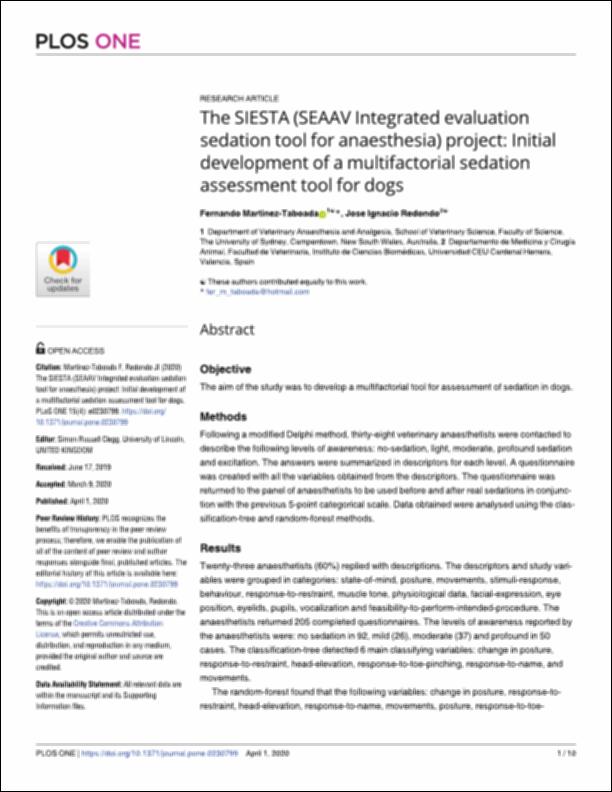Please use this identifier to cite or link to this item:
http://hdl.handle.net/10637/12612The SIESTA (SEAAV Integrated Evaluation Sedation Tool for Anaesthesia) projects : initial development of a multifactorial sedation assessment tool for dog
| Title: | The SIESTA (SEAAV Integrated Evaluation Sedation Tool for Anaesthesia) projects : initial development of a multifactorial sedation assessment tool for dog |
| Authors : | Martínez Taboada, Fernando Redondo García, José Ignacio |
| Keywords: | Analgesia veterinaria.; Analgesia (Veterinary); Perros - Anestesia.; Anestesia veterinaria.; Veterinary anesthesia.; Dogs - Anesthesia. |
| Publisher: | PLOS. |
| Citation: | Martinez-Taboada, F. & Redondo, J.I. (2020). The SIESTA (SEAAV Integrated Evaluation Sedation Tool for Anaesthesia) project: initial development of a multifactorial sedation assessment tool for dogs. PLoS ONE, vol. 15, i. 4 (01 apr.), art. e0230799. DOI: https://doi.org/10.1371/journal.pone.0230799 |
| Abstract: | Objective The aim of the study was to develop a multifactorial tool for assessment of sedation in dogs. Methods Following a modified Delphi method, thirty-eight veterinary anaesthetists were contacted to describe the following levels of awareness: no-sedation, light, moderate, profound sedation and excitation. The answers were summarized in descriptors for each level. A questionnaire was created with all the variables obtained from the descriptors. The questionnaire was returned to the panel of anaesthetists to be used before and after real sedations in conjunction with the previous 5-point categorical scale. Data obtained were analysed using the classification-tree and random-forest methods. Results Twenty-three anaesthetists (60%) replied with descriptions. The descriptors and study variables were grouped in categories: state-of-mind, posture, movements, stimuli-response, behaviour, response-to-restraint, muscle tone, physiological data, facial-expression, eye position, eyelids, pupils, vocalization and feasibility-to-perform-intended-procedure. The anaesthetists returned 205 completed questionnaires. The levels of awareness reported by the anaesthetists were: no sedation in 92, mild (26), moderate (37) and profound in 50 cases. The classification-tree detected 6 main classifying variables: change in posture, response-to-restraint, head-elevation, response-to-toe-pinching, response-to-name, and movements. The random-forest found that the following variables: change in posture, response-to-restraint, head-elevation, response-to-name, movements, posture, response-to-toe-pinching, demeanour, righting-reflex and response-to-handclap, were classified correctly in 100% awake, 62% mild, 70% moderate and 86% of profound sedation cases. Discussion and conclusion The questionnaire and methods developed here classified correctly the level of sedation in most cases. Further studies are needed to evaluate the validity of this tool in the clinical and research setting. |
| Description: | Este artículo se encuentra disponible en la siguiente URL: https://journals.plos.org/plosone/article?id=10.1371/journal.pone.0230799 |
| URI: | http://hdl.handle.net/10637/12612 |
| Rights : | http://creativecommons.org/licenses/by/4.0/deed.es |
| ISSN: | 1932-6203 (Electrónico). |
| Issue Date: | 1-Apr-2020 |
| Center : | Universidad Cardenal Herrera-CEU |
| Appears in Collections: | Dpto. Medicina y Cirugía Animal |
Items in DSpace are protected by copyright, with all rights reserved, unless otherwise indicated.


